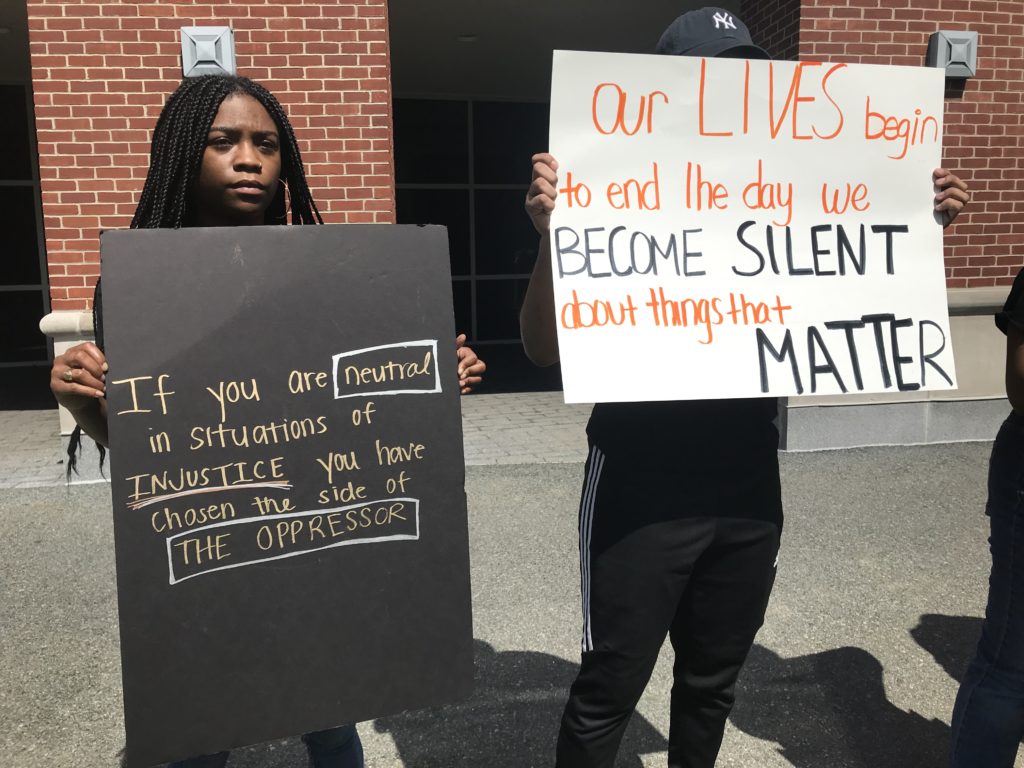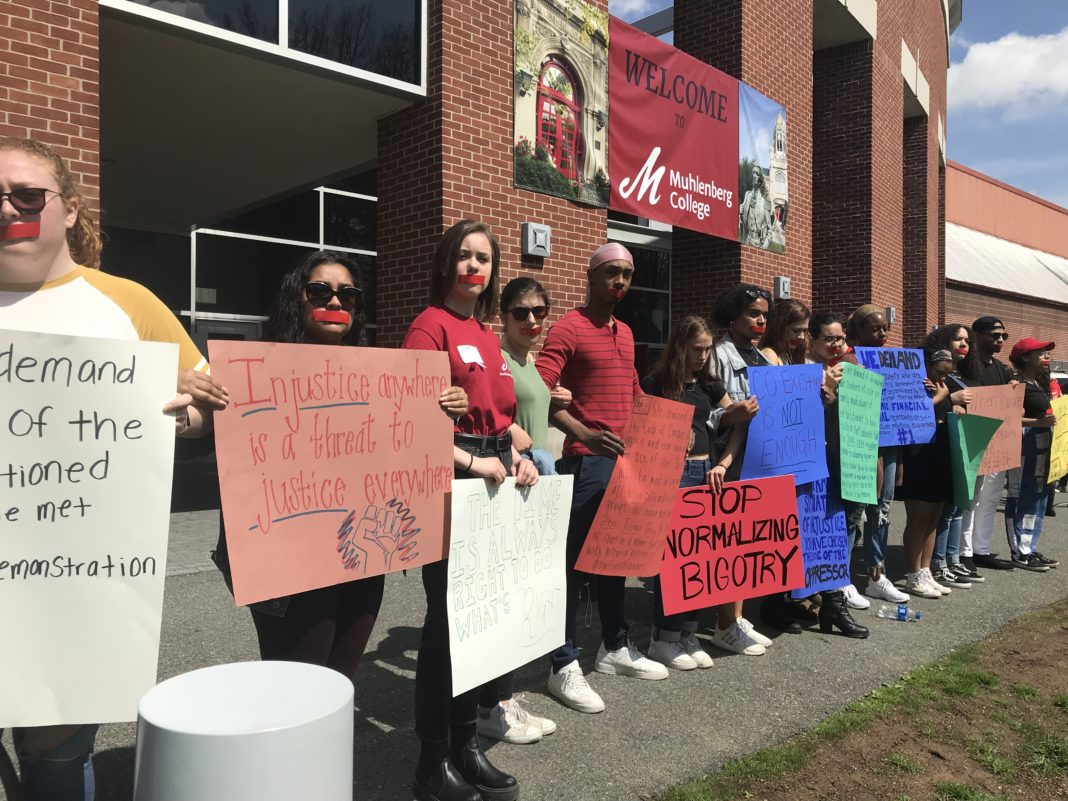On April 13, dozens of Muhlenberg students gathered in front of the Life Sports Center for a silent protest against racial bias in the school administration. As hundreds of prospective students and their families passed through the sports center for Through The Red Doors, the protesters stood, arms linked, holding up signs and wearing red tape over their mouths.
This demonstration came three days after Dean of Students Allison Gulati sent a schoolwide email addressing biased and hateful language on campus. President Williams addressed both the demonstration and the demonstrators’ complaints in another schoolwide email on Monday night.
The protest followed an alleged incident of racism on campus.
“Due to confidentiality, I can’t provide any specific information related to an ongoing student conduct issue or any individual students’ conduct record at the college,” explained Gulati to The Weekly.
In a statement released to The Weekly, the “Student Action Group” explained the purpose of their protest.
“The demonstration and its timing was not about punishing anyone. It was about creating urgency, raising awareness/visibility and creating nonviolent peaceable crisis in order to have important and pressing issues with policy, administration of said policy, racial incidents and social acts of racism etc., acknowledged so that work can begin. The protest in part was about acknowledging how the measures the college has put forth need further examination and how too often they do not adequately protect, support and ensure students of color’s access to equitable education free of discriminatory incidents.”
Gulati explained that, in addition to the “respect for others” and “respect for community” sections of the Student Code of Conduct — both of which prohibit biased language — the newly updated and recently approved Equal Opportunity and Non-Discrimination Policy addresses what she believes are student concerns about the judicial process.
“I know that there are many people across campus who have concerns about the judicial process, about the use of biased language on campus, and about making sure we’re creating the most equitable community possible,” explained Gulati. “That policy is intended to ensure that, with regard to harassment and discrimination at the college, whether it’s based on identity based bias or sexual in nature, that it’s taken with the utmost seriousness and is addressed to the fullest. So that policy specifically speaks to harassing language or discriminatory practices at the college that would prevent someone from having the full experience that they’re entitled to.”
Gulati explains that students could benefit from some changes to the current process.
“One of the things I think students are asking for right now is more specific examples of language and where it would fall in terms of a violation and what types of resulting action could come from using it. And so, that’s something we’re going to work with students [about] now. If there are any students who are interested in being part of that, to help put even more language to [the code],[they can help] to provide more transparency and understanding for students about language within the code. So that’s an improvement that we would absolutely be willing to make.”
Gulati stated that physical violence and biased language are supposed to be treated with the same level of severity.
“One thing to note is that hypothetically in any student conduct case if bias-based language was used in a significantly threatening manner it could be considered at the same level initially as physical violence, because there is an emotional harm that is severe and significant from using bias-based language on our campus. Beyond that, generally in our code if there is a complaint that someone has used that language, it would be investigated and then it would be put to a hearing board or another student conduct process where the facts would be reviewed, witnesses would be interviewed and provide their perspectives and based on that, a hearing board or an individual administrator would make a decision on responsibility as well as the sanctions that would be imposed and those sanctions could be from expulsion to a disciplinary warning at the college. And then they also typically always come with additional educational sanctions to help students learn from those transgressions.”

The Student Action Group communicated a number of their concerns with the school administration with regards to incidents of racial bias.
“[The demonstration] was also in part about saying there are holes inherently couched in this institution that has consistently left too much space for students of color to fall through the cracks,” explains the group. “We are holding our administration responsible to us, because we, too, pay the tuition that keeps salaries paid and lights on. This demonstration asked that they be transparent with us, collaborative with us and be better to us. We sent the administration 10 demands and are currently in conversation about how we can best help them make change.”
Gulati confirms receiving the group’s demands.
“We’re going to continue to look at those requests, whether they’re related to racial representation on boards and in different processes on campus, things like the bias response education team or social judicial boards, things like that. How can we continue to diversify those groups? How can we adjust the language in our policies to be more clear to students who are looking for that language? So we’re working to address their specific concerns now and we also know that we have a diversity strategic plan at the college that has already provided us a roadmap with other areas the college wants to continue to improve, like the recruitment and retention of faculty of color. And so the college is going to continue working as hard as it can to make progress on those other goals as well. But we are going to try and address some of the immediate student concerns as quickly as possible.“
Robin Riley-Casey, Director of the Multicultural Life Office and the Multicultural Center, addresses the demonstrators, saying, “I think there were a small group of students really coming together to think critically about some issues they want to address that were either personal to them or they knew of from their peers.”
Ultimately, the Student Action Group recognizes that our campus still has a lot of work to do.
“Some participants were seniors who have been interacting with racially motivated occurrences since the YikYak incident and the town hall in 2015,” they explain. “We have gotten emails expressing that changes have been made but then hear about another student of color being invisibilized. Whether that process of being made invisible takes form in an individual being suspended, being unable to finish classes or incurring other traumas forcing them to leave, have their reports not adequately or transparently followed up on, etc: the persistence of incidents like these has made it increasingly clear that this is in fact a structural issue that needs attending to. And we plan on holding the institution to that.”
Laura is a sophomore Media and Communication student in the Pre Law program. In addition to being News Editor at the Weekly, she is a DJ at Muhlenberg's radio station WMUH.






















